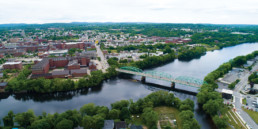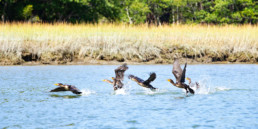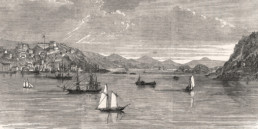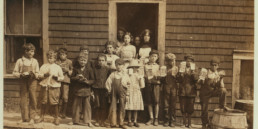Islands Were First Footholds for European Settlers
Safety and ease of transportation were attractive, historians say
By Jacqueline Weaver
At one time, 300 of Maine’s nearly 5,000 islands had year-round communities. Today that number has dwindled to 15 islands that are occupied through all four seasons.
“When Europeans got to the coast of Maine, they set themselves up on islands first, because they were uninhabited and they were, or felt, safer,” said historian Lincoln Paine, author of Down East: An Illustrated History of Maritime Maine (2000). “Only after they had the lie of the land, and of the various Wabanaki people who lived there, did they start moving onto the mainland.”
Paine said there were an estimated 400 European fishing vessels active on the Maine coast in the 1620s. Bill Caldwell, author of Islands of Maine (1981), said islands off the coast of New England, particularly Maine, were attractive because of the fertile fishing grounds there and around the entire Gulf of Maine.
“The first roots of the United States are not in the soil of the mainland, but in the fishing grounds off the coast of Maine,” Caldwell wrote. “Fishermen began this nation in rough, temporary settlements on the Maine islands.”
One of the earliest settlements by mariners from Europe was Damariscove Island off the coast of Boothbay Harbor. The two-mile long, quarter-mile wide island housed families who farmed and fished from the 1600s into the 1930s. Caldwell wrote that for centuries, fishing, boatbuilding, and lumbering drove the Maine economy, spreading down the coast from Newfoundland to the Isle of Shoals off Kittery.
The fish provided a steady food supply and a product to sell, helping to establish America’s earliest trading centers, Caldwell explained.
“The first roots of the United States are not in the soil of the mainland, but in the fishing grounds off the coast of Maine.”
—Bill Caldwell
According to the late historian Samuel Eliot Morrison in The Story of Mount Desert Island (1960), the first mariner to arrive on Mount Desert Island was Estevan Gomes, a Portuguese who was sent to find a comparable and northern version of the Panama Canal to establish a link to the Pacific. What he found was Mount Desert Island, or what he called “River of Mountains,” as he navigated along Somes Sound.
When Samuel de Champlain arrived in 1604, he called Mount Desert the “Isle Of Bare Mountains,” or “l’Isle des Monts-deserts.”
“The economy of the island settlers was based on forest and sea,” Morrison wrote. “By 1870, almost the entire first growth of timber was cut off, if not burned down, to make lumber, ship timber, and cordwood.”
A visitor in 1792 could have seen ships in Frenchman Bay sailing for London, Santo Domingo, and Boston, with cargoes of plank, timber, shooks (wood cut for barrels), bark, and cordwood.
Philip Conkling, author of Islands in Time, wrote that the mostly French and English settlers were attracted to the islands for their proximity to fishing grounds and the islands’ defensive advantages. Granite also was a part of several islands’ economic engines. At the height of the granite era in the 1880s and 1890s, Vinallhaven supported a dozen large quarries, Conkling wrote.
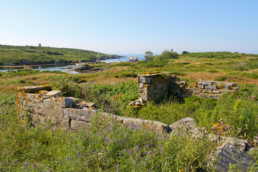
The remains of centuries-old settlements
on Damariscove Island.
“At one time there were 33 major island quarries among Maine islands stretching from Friendship to Jonesport,” he wrote. The granite was used for breakwaters, paving blocks, libraries, monuments and memorials, and cobblestones. The granite era ended with the introduction of cement, since the material was cheaper and easier to handle, Conkling notes.
Also adding to the industry’s demise, he noted, were an end to lucrative government contracts, construction of railroads on the mainland, and labor unrest.
But the true beginning of the end for Maine’s islands was the invention of the internal combustion engine. The car ended the heyday of the steamboat, which carried passengers, and the schooner and other cargo ladened vessels.
Paine said that prior to development of the car and roads, boats were the easiest way to move along the coast of Maine, easily connecting to islands, peninsulas, and around the entire Gulf of Maine. A boat with one to two people could handle the equivalent of a truckload of cargo and a busload of people. But the advent of the car gave people an unprecedented mobility.
“If your primary means of transportation was boats, you didn’t have much incentive or ability to go inland ever if you went to the mainland,” said Paine. “But with cars, you could go to Rockland or Portland and hit the open road.”
The decline of the boat culture and the rise of the car culture is evident in the demise of the steamboat lines in the 1930s. The night boats between Boston and Bangor stopped running only four years after the opening of the Waldo-Hancock Bridge in 1931.
“Cars connected the archipelagoes of cities and towns around the country the same way that boats had connected the archipelago of islands and towns on the coast of Maine,” Paine said.
The transportation revolution had a major impact on peninsula towns as well because the towns were tied to the islands as much as, or even more than, to other mainland towns.
“So you can imagine Route 1 as nipping the peninsulas off one by one as it heads down the coast,” Paine said.


